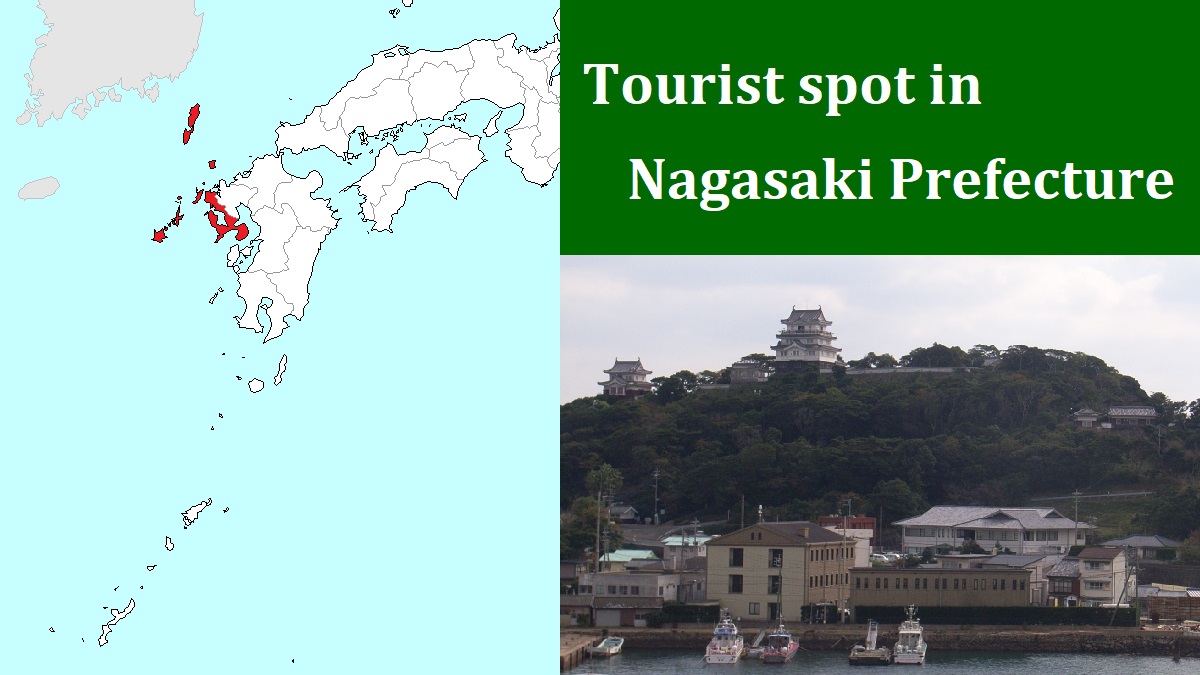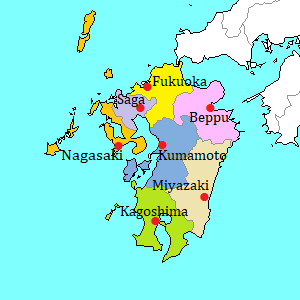Fukue Island [福江島]
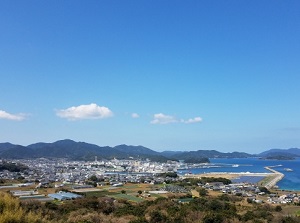
Fukue district
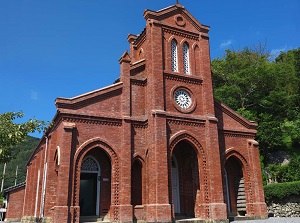
Dozaki Church in Fukue Island
Photo by (c)Tomo.Yun
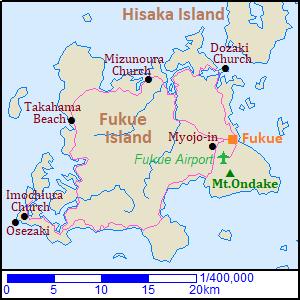
Fukue Island ("Fukuejima" in Japanese) is the main island of Goto Islands (五島列島).
Goto Islands is located about 50 to 100 km west of the mainland of Nagasaki Prefecture.
"Goto" means "Five islands".
Literally, five large islands line from northeast to southwest and the length of area is about 80 km.
There are many small islands around the main islands, and the total number is 152.
Fukue Island is at the south end of them, and is about 30 km from east to west and about 25 km from north to south in width.
The administrative name of the island is "Goto city", and the central area is Fukue district on the east coast.
There is a ferry port and Fukue Airport is located about 3 km south of the district.
The distance from Nagasaki city is about 100 km.
From ancient times to medieval times, this island had been the stopping point to China.
In the 7th century, Japanese official diplomatic delegations were sent to China during the Sui dynasty (current China).
They started from Osaka and stopped by this island.
And they ventured to cross the East China Sea from here.
From the 14th to 16th centuries, Chinese merchants came to this islands often as a stopping point between Nagasaki city and China.
At that time, Goto Islands including Fukue Island were very far away from the mainland of Japan.
So many hidden Christians moved from the mainland to Goto Islands, after Christianity was banned in the late 16th century.
After lifting the ban on Christianity in 1873, about 50 churches were built in Goto Islands by the Christians.
It is the most proportion of churches to the population in Japan.
Over half of them are in Nakadori Island (中通島) at the north part of Goto Islands.
There are 13 churches in Fukue Island.
Therefore, Fukue Island has the mood that is a mixture of nature, traditional Japan, China and Christianity.
To tour around this island, we can use route bus, regular sightseeing bus, rental car or sightseeing taxi.
This island is mountainous, so it is very hard to tour around by rental bicycle.
Around Fukue district
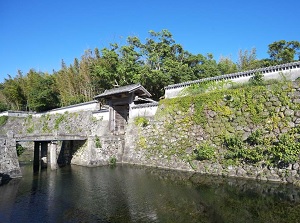
Ishida Castle
Photo by (c)Tomo.Yun
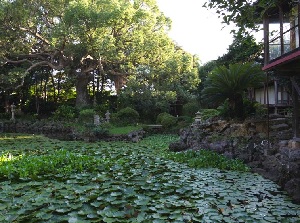
Japanese garden in Ishida Castle
Photo by (c)Tomo.Yun
There is the ruin of Ishida Castle (石田城) about 0.7 km southwest of Fukue Port.
It is also called "Fukue Castle".
A castle had been built in the middle ages, but it was destroyed by fire in 1614.
For a long time, the construction of the new castle had not been allowed, but it was allowed to construct in 1849 because of monitoring the ships from modern strong countries.
The new castle was completed in 1863, but the feudal period had ended.
So this castle was demolished in 1872.
Now, a part of the site is open to the public.
There is the Japanese garden built in 1858, and it is said that this garden was modeled after Kinkakuji's garden in Kyoto.
But it is unique that the plants in the warm regions such as betel palm, sago palm, etc. are used and the stones are made of lava.
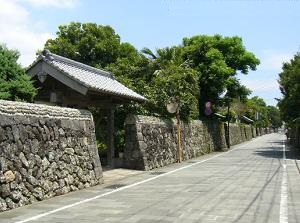
Bukeyashiki Street
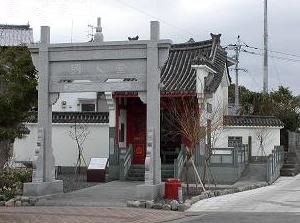
Minjindo
And there is Bukeyashiki Street (武家屋敷通り) about 300 meters south of Ishida Castle.
"Bukeyashiki" means "samurai residence".
The samurais serving in Ishida Castle had lived in this area since 1634.
The fences are unique.
The base stones are made of lava, and many round stones are put on them.
Minjindô (明人堂) is a small Chinese temple located about 700 meters north of Ishida Castle and by Fukue River.
In 1540, a Chinese merchant came to carry out trade.
Then, Chinese merchants were allowed to live in Fukue, and they built this Chinese temple.
Current temple was rebuilt in 1999.
The stones were carried from China, and Chinese carpenters built the temple.
And a hexagon well is located about 150 meters south of Minjindô.
It was also constructed by Chinese people who lived around here.
Spots to the south of Fukue district
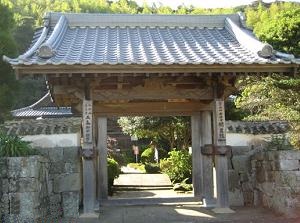
Myojo-in temple in Fukue Island
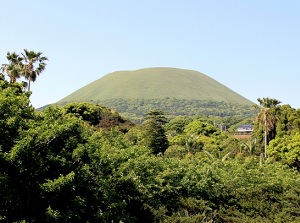
Ondake in Fukue island
There is Myôjô-in temple (明星院) about 3 km southwest of Fukue district.
It is a temple of Shingon Buddhism.
High priest Kuukai (774-835) studied in China from 804 to 806, and he came to Fukue Island on the way back to Japan.
When he prayed in this place, he saw Venus shining brilliantly in the sky.
He thought it was a sign of good luck, so he established this temple.
He named the temple "Myôjô-in".
"Myojo" means "bright star, Venus".
Later, Kuukai founded Kongobuji temple in Mount Koya around 819.
Current main temple was rebuilt in 1778 after the destruction by fire.
The ceiling painting is attractive.
In the southern area of Fukue district, a low lava plateau spreads and forms a round peninsula.
The diameter is about 5 km.
About 3 million years ago, some volcanos erupted and the lava plateau was formed.
Then thousands years ago, the second eruption occured, and some mountains were formed on the lava plateau.
One of them is Ondake (鬼岳, 315 m).
It is the central mountain is covered with lawn grass, so it has been familiar to Fukue residents as a playground.
It is located about 4 km south of Fukue district and about 1 km southeast of Fukue Airport.
Christian churches and other spots
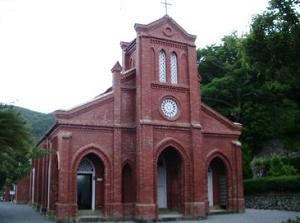
Dozaki Church in Fukue Island
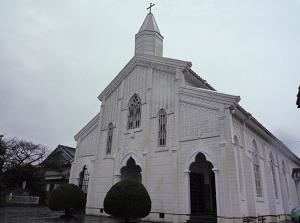
Mizunoura Church in Fukue Island

Dôzaki Church (堂崎天主堂, "Dôzaki Tenshudo" in Japanese) is a church located on a small peninsula about 9 km north of Fukue district.
Soon after lifting of the ban of Christianity in 1873, a French priest was invited in this island.
And the first church was built in 1879, then current church was constructed in 1908.
By route bus for Togi, about 20 minutes from Fukue to Douzaki-Tenshudou iriguchi stop.
Mizunoura Church (水ノ浦教会, "Mizuniora Kyôkai" in Japanese) is a church located about 15 km northwest of Fukue district.
It was founded in 1880, and current wooden church was completed in 1938.
By route bus to Miiraku, about 33 minutes from Fukue to Mizunoura stop.
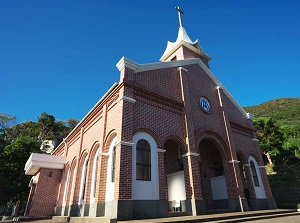
Imochiura Church in Fukue Island
Photo by (c)Tomo.Yun
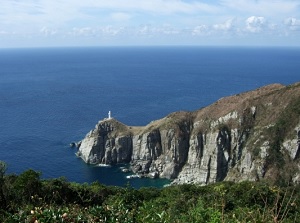
Cape Osezaki
Imochiura Church (井持浦教会, "Imochiura Kyôkai" in Japanese) is a church located about 30 km west-southwest of Fukue district.
It was built in 1895.
And, Japan's first holy spring at Lourdes were constructed in this church in 1899.
By route bus to Tamanoura, about 1 hour and 20 minutes from Fukue to Rurudo-mae stop.
Cape Ôsezaki (大瀬崎) is a cape at the southwestern edge of Fukue Island.
It is located about 1.5 km southwest of Imochiura Church.
But there is a mountain between the church and the cape, so the length of road to the cape is about 4.5 km.
The cape is surrounded with the cliffs about 100 to 160 meters high.
On the tip of the cape, there is a lighthouse.
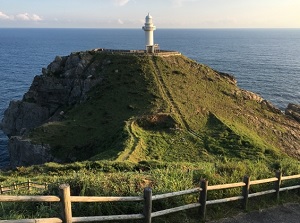
Lighthouse of Cape Osezaki
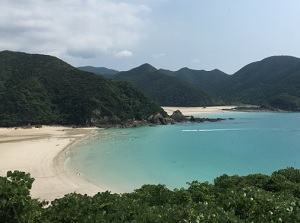
Takahama Beach
About 20 km north of Cape Ôsezaki, there is Takahama Beach (高浜海水浴場).
It is very beautiful sand beach.
The color of the water is wonderful and the view of sunset is also good.
But there is no route bus to this beach.
How to get here
By airplane, to Goto Fukue Airport, about 40 minutes from Fukuoka, about 30 minutes from Nagasaki.
Then, by route bus, about 10 minute to Fukue district.
Or, by high-speed ship, about 1 hour and 25 minutes from Nagasaki Port to Fukue Port.

